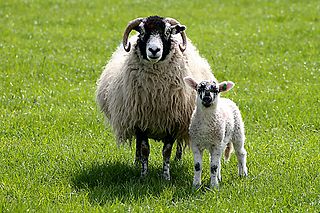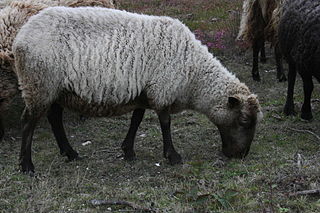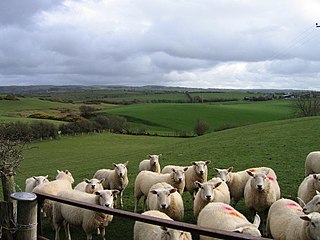| Look up blackface in Wiktionary, the free dictionary. |
Blackface is a theatrical makeup to portray a stereotype of African Americans.
Contents
Blackface may also refer to:
| Look up blackface in Wiktionary, the free dictionary. |
Blackface is a theatrical makeup to portray a stereotype of African Americans.
Blackface may also refer to:
| This disambiguation page lists articles associated with the title Blackface. If an internal link led you here, you may wish to change the link to point directly to the intended article. |

Blackface is a term which is used to describe a form of theatrical make-up which is predominantly used by non-black performers in order to represent a caricature of a black person. The term is also used in reference to black makeup which is worn as part of folk traditions and disguising, not all of which are perceived as or originated as racial stereotypes of black people.

The Blackface or Scottish Blackface is a British breed of sheep. It is the most common sheep breed of the United Kingdom. Despite the name, it did not originate in Scotland, but south of the border.

Swaledale is a breed of domestic sheep named after the Yorkshire valley of Swaledale in England. They are found throughout the more mountainous areas of Great Britain, but particularly in the Yorkshire Dales, County Durham, and around the pennine fells of Cumbria.

The Suffolk is a British breed of domestic sheep. It originated in the late eighteenth century in the area of Bury St. Edmunds in Suffolk, as a result of cross-breeding when Norfolk Horn ewes were put to improved Southdown rams. It is a polled, black-faced breed, and is raised primarily for its meat. It has been exported to many countries, and is among the most numerous breeds of sheep worldwide.
The Hebridean is a breed of small black sheep from Scotland, similar to other members of the Northern European short-tailed sheep group, having a short, triangular tail. They often have two pairs of horns. They were often formerly known as "St Kilda" sheep, although unlike Soay and Boreray sheep they are probably not in fact from the St Kilda archipelago.
The Lonk is a domestic sheep of a specific breed, found in the hills of the central and south Pennines, in the north of England. The name "Lonk" derives from the Lancashire word "lanky", meaning long and thin, usually in a person. Their range extends into only three counties; Lancashire, Yorkshire and Derbyshire. Also known as the Improved Haslingden, the Lonk is of the Blackfaced Mountain type, and is similar to the Derbyshire Gritstone, apart from the absence of horns in that breed.

The Balwen Welsh Mountain sheep is one of a number of varieties of Welsh Mountain sheep, bred for sheep farming in Wales. It has a distinctive colour pattern of a black body with white extremities. It originates in the Tywi valley in Wales. This breed is raised primarily for meat.
Whiteface may refer to:
In sheep farming, the term mule is used to refer to a cross between a Bluefaced Leicester ram and a purebred hill ewe.

The Norfolk Horn is one of the British black-faced sheep breeds. It differs from other black-faced breeds, which are mainly found in high-rainfall, upland areas, and from most other modern, lowland British sheep breeds in being lightly built and very hardy. This breed is raised primarily for meat.

Welsh Mountain sheep are small, hardy sheep from the higher parts of the Welsh mountains. The males have horns, and the females are polled (hornless); they have no wool on the face or legs, and they have long tails. There are a number of varieties, bred for sheep farming in Wales. These are mainly colour variations, but some are being developed as separate breeds.

The Black Welsh Mountain sheep is a colour type of the Welsh Mountain sheep, bred for sheep farming in Wales. It occurs occasionally in flocks of other colours, but is now often maintained as a separate strain. Like other Welsh Mountain sheep it is found mainly on the hills in Wales, but is also kept elsewhere. The worldwide population of Black Welsh Mountain sheep is approximately 10000. A breeders' society for Black Welsh Mountain Sheep was formed in 1920 at the Smithfield Show.

The Boreray, also known as the Boreray Blackface or Hebridean Blackface, is a breed of sheep originating on the St Kilda archipelago off the west coast of Scotland and surviving as a feral animal on one of the islands, Boreray. The breed was once reared for meat and wool, but is now used mainly for conservation grazing. The Boreray is one of the Northern European short-tailed sheep group of breeds.
The Llanwenog is a breed of domestic sheep originating in Wales. It was developed in the 19th century from the Llanllwni, the Shropshire, Welsh Mountain, and Clun Forest breeds. The Llanwenog's native locale is the Teifi Valley, in western Wales, but it has since spread into other areas. The breed association was formed in 1957. Llanwenogs have black faces and medium-length wool. They have a docile temperament and are known for their profligacy in lambing. The breed has a very placid temperament, is easily handled, easily contained and is well suited to stress free inwintering if necessary. This has important consequences for the health of both the animal and its keeper. This breed is raised primarily for meat.

The Dalesbred is a breed of domestic sheep originating in England. Derived from the Swaledale and Scottish Blackface breeds, the Dalesbred is a northern hill breed distributed in the Yorkshire Dales and into Lancashire. The Dalesbred is genetically distinct from the other northern hill breeds, the Herdwick and Rough Fell.

Northern European short-tailed sheep are a group of sheep breeds and landraces now limited to parts of the British Isles, Scandinavia, Greenland and the area around the Baltic. They are thought to be derived from the first sheep brought to Europe by early farmers, and for thousands of years they were the only type of sheep kept in northern Europe. They are hardy sheep, adapted to harsh environments, but they are small and have been replaced in most areas with later types of larger, long-tailed sheep.

The Newfoundland, also called the Newfoundland Local, is a breed of sheep native to Newfoundland.

The Scottish Dunface, Old Scottish Short-wool, Scottish Whiteface or Scottish Tanface was a type of sheep from Scotland. It was one of the Northern European short-tailed sheep group, and it was probably similar to the sheep kept throughout the British Isles in the Iron Age. By the mid-nineteenth century it had mostly been displaced by the Scottish Blackface and it became extinct on the mainland of Scotland in the late nineteenth century. However, several local types of Dunface survived on islands around Scotland, giving rise to or contributing to existing breeds including the Shetland, North Ronaldsay, Hebridean and Boreray.

Sheep farming has been important to the economy of Wales. Much of Wales is rural countryside and sheep are seen throughout the country. The woollen industry in Wales was a major contributor to the national economy, accounting for two-thirds of the nation's exports in 1660. Sheep farms are most often situated in the country's mountains and moorlands, where sheepdogs are employed to round up flocks. Sheep are also reared, however, along the south and west coasts of Wales. In 2017 there were more than 10 million sheep in Wales and the total flock made up nearly 33% of the British total. In 2011 sheep farming accounted for 20% of agriculture in Wales.
The Watch list of the Rare Breeds Survival Trust is a listing of rare and native United Kingdom breeds of domestic cattle, sheep, pigs, horses, goats and poultry, compiled by the Rare Breeds Survival Trust.